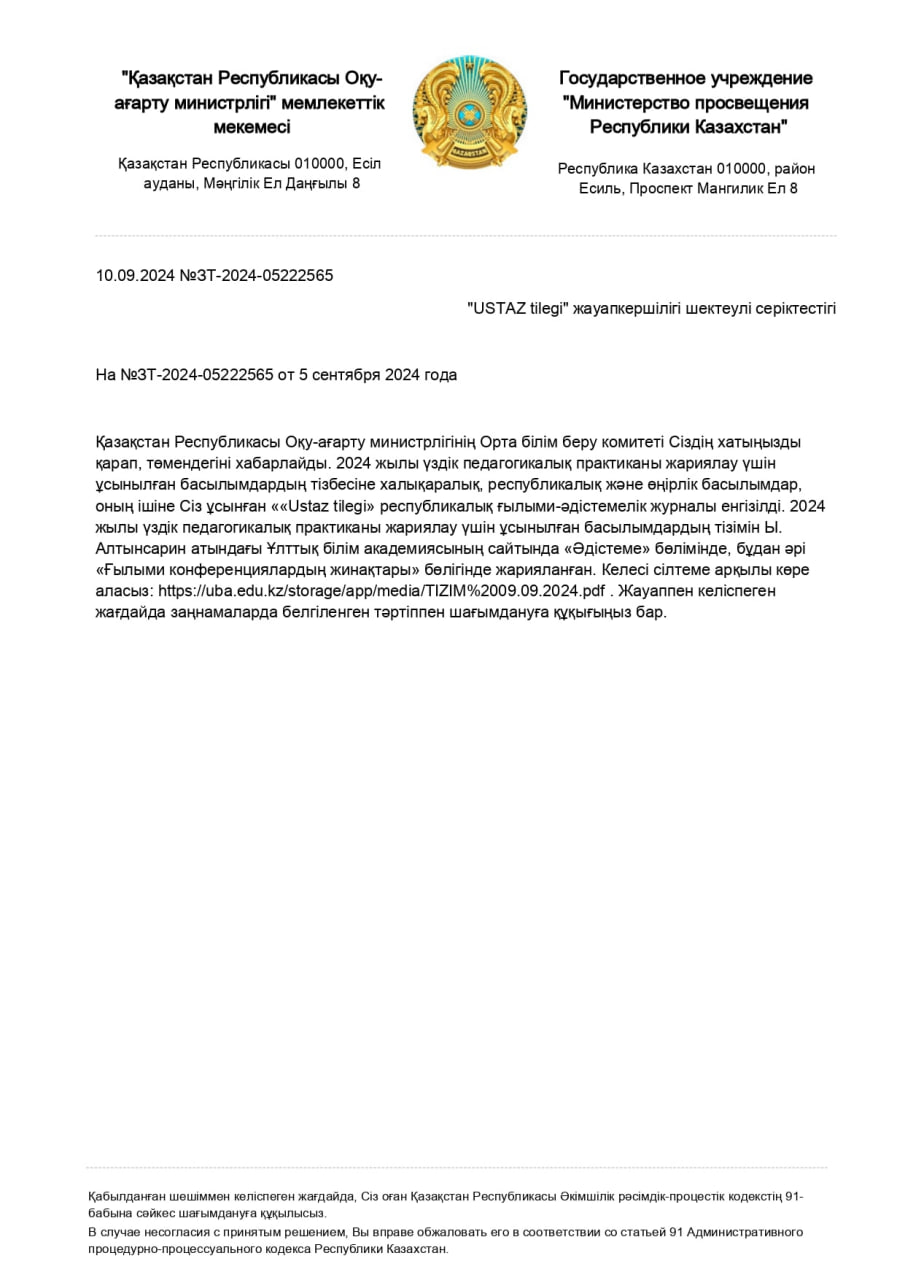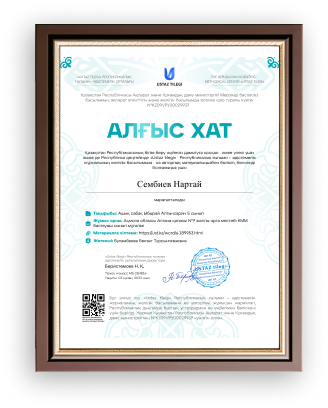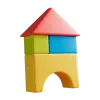
|
Term 1. Unit 1 "Hobbies and qualities"
|
School: |
||
|
Date: |
Teacher name: |
||
|
Grade: 9 A |
Number present: |
absent: |
|
|
Lesson title |
Reading: Comparing generations. |
||
|
Learning objectives
|
9.4.2.1 understand specific information and detail in texts on a range of familiar general and curricular topics, including some extended texts. 9.6.14.1 use an increased variety of prepositions before nouns and adjectives use a growing number of dependent prepositions following nouns and adjectives and an increased variety of dependent prepositions following verbs on a range of familiar general and curricular topics 9.5.3.1 write with moderate grammatical accuracy on a wide range of familiar general and curricular topics |
||
|
Lesson objectives |
Learners will be able to:
Express their opinions about different generations building extended sentences. |
||
|
Plan |
|||
|
|
|||
|
Stages / Time Beginning 5min |
Teachers’ actions |
Students’ actions |
Assessment criteria |
Resources |
|||||||||
|
1.Greeting. Ask about the weather. Pre-teaching vocabulary
Warm-up 1/ Describe the given picture. 2/ What is the message conveyed by it? • With books closed, ask students if they have seen photographs of their parents and grandparents when they were young. Lead – In What do you think life was like in the 1950s? Which of these things do you think were common in the 1950s? Which are common now? In differentiation part«Think and share» method was used to check up student’s vocabulary knowledge. |
Students respond to greeting The wish flower” method helps to start the lesson with good wishes to each other. The aim: To develop Ss speaking skills and create friendly atmosphere Efficiency: By telling the wishes they show their appreciations . Sts try to answer the questions using student’s vocabulary knowledge. They think and share their answer |
At the organization moment T tries to award active Ss. «The praise» method is used to evaluate Ss with phrases like: “Good job! Well done!” Good job!
|
Pictures PPT |
||||||||||
|
Main part 5min 9 min 6min 5min 10min |
Pre- Reading Activity. Task 1 (S, R, I.W) Teacher asks: what do you think life was like in the 1950s? Students give their answer. Prediction based on the vocabulary. Detailed reading. Comparing. While-reading Exercise 2 - Task 2 (R, I. W, Dif. tasks) Knowing each student’s level of knowledge, teacher gives everybody the task. For A learners- teacher gives sentences (based on the texts) to correct the false ones.
For B learners- teacher gives the exercise, based on the texts. Exercise should be done by completing the sentences with appropriate preposition using support in the box and your own ideas.
1.I`m not very fond ___... 2.I never get bored ___... 3.These days people are crazy _... 4.I`m not very good ___... 5.Marilyn Monroe was famous __.. 6.… today are different ___ those in the fifties For C learners – teacher gives the questions to answer them.
Task 3 (S, GW) Teacher divides the class into 2 groups – «young generation» and «old generations». Students should read the texts one more time and make debates proving hobbies of young or old generation. Every member of the group should take part in discussion, should be involved in work process. |
Students express their ideas Descriptor: 1. Read the texts. 2. Find out that part of information, which of different trades of old and young generations. 3. Present your report orally.
Descriptor:
Students read, listen and compare their answers with the text. Descriptor:
Complete the sentences by your own ideas Descriptor:
Descriptor:
|
Assessment: Teacher assesses himself/herself by giving oral feedback to each student. 3 points-great work, the student knows how to work with information, operates with grammar forms freely. 2 points-good work, the student understands the distinction between old and young generations. 1 point-this student should work harder and be more attentive while reading.
Assessment: Teacher counts how many variants were right. 7-8points- excellent! 4-6 points –good work! 1-3 try hard!
Assessment: Teacher counts how many variants were right. 5-6 points- excellent! 3-4 points –good work! 1-2 try hard!
Assessment: Teacher counts how many variants were right. 4 - answers- excellent! 2-3 - answers –good work! 1- answers - try hard!
Assessment: Groups assess each other be oral feedback. Teacher makes a conclusion by his own feedback orally. |
Student’s book
Worksheets
Student’s book
|
|||||||||
|
End 5 min
|
Giving the hometask. WB p.10 Self-reflection Reflection “Thank you” The teacher also thanks his class for working at the lesson. |
At the end of the lesson each student says thank you to members of other group, whose work, help, answer was useful for him.
|
Students use their stickers to show their knowledge according to the lesson. |
Poster Success |
|||||||||
|
Term 1. Unit 1 "Hobbies and qualities"
|
School: |
||
|
Date: |
Teacher name: |
||
|
Grade: 9 A |
Number present: |
absent: |
|
|
Lesson title |
Reading: Comparing generations. |
||
|
Learning objectives
|
9.4.2.1 understand specific information and detail in texts on a range of familiar general and curricular topics, including some extended texts. 9.6.14.1 use an increased variety of prepositions before nouns and adjectives use a growing number of dependent prepositions following nouns and adjectives and an increased variety of dependent prepositions following verbs on a range of familiar general and curricular topics 9.5.3.1 write with moderate grammatical accuracy on a wide range of familiar general and curricular topics |
||
|
Lesson objectives |
Learners will be able to:
Express their opinions about different generations building extended sentences. |
||
|
Plan |
|||
|
|
|||
|
Stages / Time Beginning 5min |
Teachers’ actions |
Students’ actions |
Assessment criteria |
Resources |
|||||||||
|
1.Greeting. Ask about the weather. Pre-teaching vocabulary
Warm-up 1/ Describe the given picture. 2/ What is the message conveyed by it? • With books closed, ask students if they have seen photographs of their parents and grandparents when they were young. Lead – In What do you think life was like in the 1950s? Which of these things do you think were common in the 1950s? Which are common now? In differentiation part«Think and share» method was used to check up student’s vocabulary knowledge. |
Students respond to greeting The wish flower” method helps to start the lesson with good wishes to each other. The aim: To develop Ss speaking skills and create friendly atmosphere Efficiency: By telling the wishes they show their appreciations . Sts try to answer the questions using student’s vocabulary knowledge. They think and share their answer |
At the organization moment T tries to award active Ss. «The praise» method is used to evaluate Ss with phrases like: “Good job! Well done!” Good job!
|
Pictures PPT |
||||||||||
|
Main part 5min 9 min 6min 5min 10min |
Pre- Reading Activity. Task 1 (S, R, I.W) Teacher asks: what do you think life was like in the 1950s? Students give their answer. Prediction based on the vocabulary. Detailed reading. Comparing. While-reading Exercise 2 - Task 2 (R, I. W, Dif. tasks) Knowing each student’s level of knowledge, teacher gives everybody the task. For A learners- teacher gives sentences (based on the texts) to correct the false ones.
For B learners- teacher gives the exercise, based on the texts. Exercise should be done by completing the sentences with appropriate preposition using support in the box and your own ideas.
1.I`m not very fond ___... 2.I never get bored ___... 3.These days people are crazy _... 4.I`m not very good ___... 5.Marilyn Monroe was famous __.. 6.… today are different ___ those in the fifties For C learners – teacher gives the questions to answer them.
Task 3 (S, GW) Teacher divides the class into 2 groups – «young generation» and «old generations». Students should read the texts one more time and make debates proving hobbies of young or old generation. Every member of the group should take part in discussion, should be involved in work process. |
Students express their ideas Descriptor: 1. Read the texts. 2. Find out that part of information, which of different trades of old and young generations. 3. Present your report orally.
Descriptor:
Students read, listen and compare their answers with the text. Descriptor:
Complete the sentences by your own ideas Descriptor:
Descriptor:
|
Assessment: Teacher assesses himself/herself by giving oral feedback to each student. 3 points-great work, the student knows how to work with information, operates with grammar forms freely. 2 points-good work, the student understands the distinction between old and young generations. 1 point-this student should work harder and be more attentive while reading.
Assessment: Teacher counts how many variants were right. 7-8points- excellent! 4-6 points –good work! 1-3 try hard!
Assessment: Teacher counts how many variants were right. 5-6 points- excellent! 3-4 points –good work! 1-2 try hard!
Assessment: Teacher counts how many variants were right. 4 - answers- excellent! 2-3 - answers –good work! 1- answers - try hard!
Assessment: Groups assess each other be oral feedback. Teacher makes a conclusion by his own feedback orally. |
Student’s book
Worksheets
Student’s book
|
|||||||||
|
End 5 min
|
Giving the hometask. WB p.10 Self-reflection Reflection “Thank you” The teacher also thanks his class for working at the lesson. |
At the end of the lesson each student says thank you to members of other group, whose work, help, answer was useful for him.
|
Students use their stickers to show their knowledge according to the lesson. |
Poster Success |

















